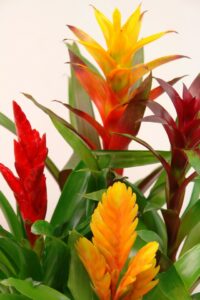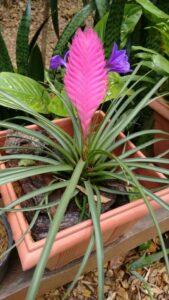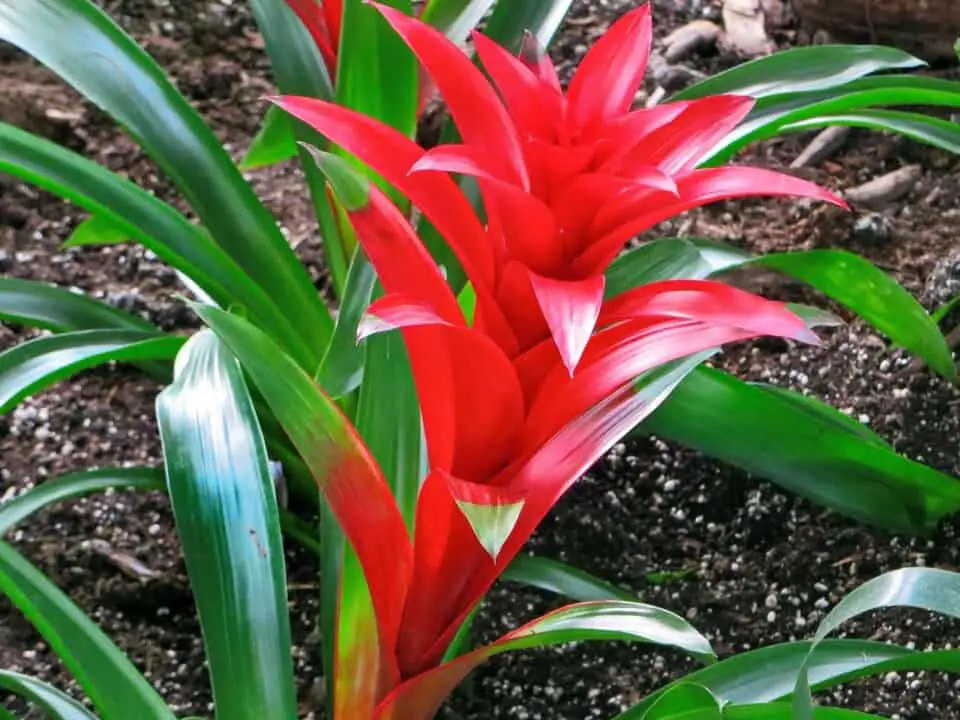Some links in the post are affiliate links and I get a commission from purchases made through some links found in the post.
If I were to offer advice to all budding gardeners, this would be it: Anytime your plant’s leaves start yellowing, please review your watering schedule. And don’t stop there.
Check the plant’s roots too for signs of damage. Why? Yellowing is often a sign that your plant is not getting enough nutrients, which often results from root damage.
And this can owe to overwatering, which causes root rot or even fertilizer burn.
Now, does this rule of thumb apply to bromeliads? Yes! If your bromeliad has shown signs of yellowing, the chances are high that overwatering has something to do with it.
The main causes of your bromeliad leaves turning yellow include overwatering, pest infestations, poor humidity regulation, aging, and inadequate lighting. I detail how each of these affects your bromeliad and how you can deal with each cause:
Why Are My Bromeliad Leaves Turning Yellow?
A bromeliad turning yellow – you probably did not have that in mind when you planted the bromeliad.
Instead, you were eager to see its colorful bracts brightening your space for months at a time. So, what could have gone wrong, and how can you fix it?
Aging
 Human beings have found ways to keep old age at bay. Everywhere you look, there’s a new potion, injection, or even treatment to help you look and feel younger.
Human beings have found ways to keep old age at bay. Everywhere you look, there’s a new potion, injection, or even treatment to help you look and feel younger.
And while this works for humans, we are yet to find a way to delay aging in plants (at least for the most part). So, sometimes, the yellowing you see on your bromeliad can signify that its lifecycle is coming to an end.
But how can you know that this is the case for sure? Easy! You look at whether the plant has new growth. New leaves should come out looking green and healthy.
If they appear yellow too and are not even mature, then aging is not the cause in this case. Instead, you need to consider the factors I have included below.
But if the yellowing is only in the mature leaves that are about to fall off, aging is the cause.
How to Fix Aging
Uhm- there’s nothing you can do about aging as it is a natural process. However, you can delay it by providing the plant with its essential requirements.
But this only works for so long. Eventually, the yellowing will start showing, and you will have no choice but to embrace it. If it’s such an issue, you can cut off the yellow leaves using a sharp sterilized knife.
It allows the plant to refocus its energy on the new leaves, boosting its overall growth. I would not go as far as pruning the aging leaves, but if this works for you, by all means, go ahead and cut the leaves.
You may also like: How big does a bromeliad get
Overwatering
Like many other houseplants, the bromeliad does not like sitting in water for too long. While it is a tropical plant, it’s yet to adapt to consistently wet soil. So, what can cause overwatering for the bromeliad?
1) Watering the plant when it does not need water
The bromeliad prefers moist rather than soggy soil. Ideally, you should only water it when its top layer of soil is dry.
And usually, the plant will withstand a few days of dry soil without wilting.
When you water the plant too frequently or too much, the roots sit in water for too long, encouraging root rot which damages the roots.
2) Using the wrong potting mix
The choice of potting mix for the bromeliad should be well-draining. Otherwise, it holds too much water, which is a recipe for root damage.
3) Inadequate drainage holes
Excess water remains in the pot when you use a pot that has blocked or insufficient drainage holes. And it’s only a matter of time before this damp environment becomes an ideal home for fungi that trigger root rot.
Poor lighting also affects how fast a plant uses up water. Without enough lighting, a plant does not absorb much water because its transpiration and evaporation rates suffer a decline.
And as a result, even when you are offering the plant water only when it needs it, the bromeliad can still start turning yellow. I will get into lighting at a later section.
You may also like: Why is my bromeliad plant turning brown
How to Fix Overwatering
Seeing as many reasons could result in overwatering, let’s deal with each cause individually:
1) Overwatering
 If you have been giving the plant too much water, you will need to cut back on the watering schedule. Only water the plant when the top inch of soil feels dry to the touch.
If you have been giving the plant too much water, you will need to cut back on the watering schedule. Only water the plant when the top inch of soil feels dry to the touch.
You can test this by digging into the potting mix and assessing how dry or moist it is. I know this can be tricky, and I would advise you to get a moisture meter to help you get an accurate reading.
2) The wrong potting mix
While the bromeliad prefers well-draining soil, it should not drain so much that it leaves the plant without enough moisture.
The easy way to balance this is by mixing one part of sand with two parts of peat-based soil. That allows water to pass easily while retaining just enough to support plant growth.
A pot with few or blocked drainage holes
Always check your plant’s pot to ensure its drainage holes are free of obstructions.
Moreover, use pots with enough drainage holes and ensure that the pot does not sit in water as this can result in more water absorption.
How Should You Deal with a Bromeliad with Root Rot?
If your bromeliad has suffered root rot, you should inspect just how bad the damage is by assessing what’s left of the roots.
If most of the roots are intact, use a sharp sterilized knife to cut off the damaged roots, then dip the plant in a fungicide.
Transfer the plant to an appropriate potting mix (one part sand and two parts peat-based potting soil) and water the plant just enough to soak the soil. Then leave the plant in a spot with adequate light and give it time to recover.
In the future, adhere to the correct watering schedule and do not water the plant when in doubt.
Poor Lighting
Did you know that lighting impacts how well your plant does? Your bromeliad requires light to make food which gives it the energy to produce more leaves, grow taller, and give rise to bracts.
And in the absence of enough light, the plant cannot sustain such activities. So, it uses the energy left to grow longer stems, resulting in leggy growth as it searches for more light.
But such a plant will not exhibit yellow leaves. Instead, it will have dark green leaves. A plant that receives too much light can burn under direct sun exposure, reducing its ability to make food. Thus, such a plant shows yellowing.
How to Fix Poor Lighting
Lighting needs in bromeliads are different. Some prefer bright and indirect light, while others can do well even in the full sun.
Given that this is a general article about bromeliads and not one focused on your specific species, I will use a general rule of thumb.
If you notice that your bromeliad has shown signs of turning yellow, take this as a sign that it needs less light to sustain its needs. But if the plant shows signs of elongation coupled with dark green leaves, you will need to increase its lighting.
For more on lighting, check out our article on the bromeliad light requirements.
Pest Infestations
Pest attacks are not common in bromeliads. However, you must remember that pests attack plants with weakened immune systems.
For example, if a plant does not get sufficient light and cannot make enough food, it is weak. And that leaves it prone to pests like scale, mealybugs, and aphids.
Dealing with Pest Infestations
If you suspect that your plant has suffered a pest attack, you will need to inspect the plant closely. Most pests are not visible to the naked eye, and you will thus need to use a magnifying glass to assess the plant.
If you notice signs of infestation, isolate the affected plant and spray it using a mixture of warm water and dish soap.
However, please note that the best management method will come down to the pest in question. For example, scale is best treated using rubbing alcohol.
Here’s an easy way to keep pests from bugging your plant – use neem oil on the bromeliad. It will be a while before they come a-calling again.
But to be safe, give your plant what it needs, which will strengthen its immune system.
if you’re enjoying this article, check out our article on the 6 great benefits of having a bromeliad in your home.
Low Humidity
The bromeliad is a tropical plant and thus does best in hot and humid conditions. When the humidity levels fall below what is acceptable, the plant suffers as its leaves dry out fast.
At first, the leaves react by drooping, then browning on the edges. And if you do not act at this point, they start yellowing which paves the way for more browning before leaf drop ensues.
Dealing with Low Humidity
 The bromeliad prefers humidity levels of at least 60%. And you can ensure this by:
The bromeliad prefers humidity levels of at least 60%. And you can ensure this by:
- Misting it frequently,
- Installing a humidifier in the room,
- Leaving kitchen and bathroom doors open, and
- Placing a bowl of water near the plant.
These measures increase the evaporation rates in the room, affording the plant more water vapor.
Final Thoughts
If you can master these yellowing-prevention techniques down to an art, your plant should only turn yellow due to aging. Happy Gardening!

